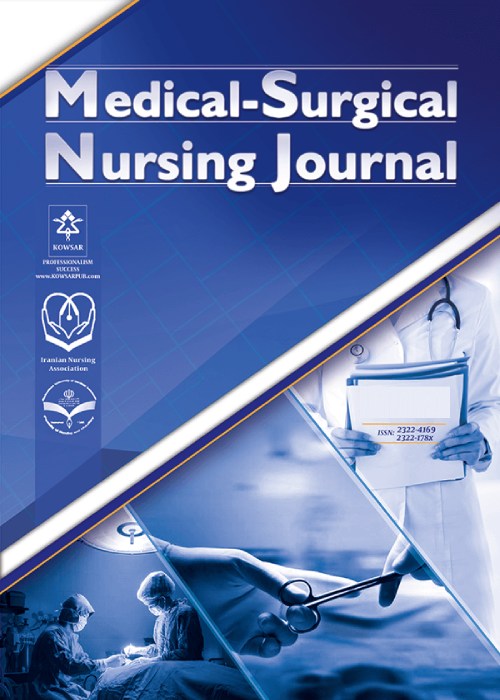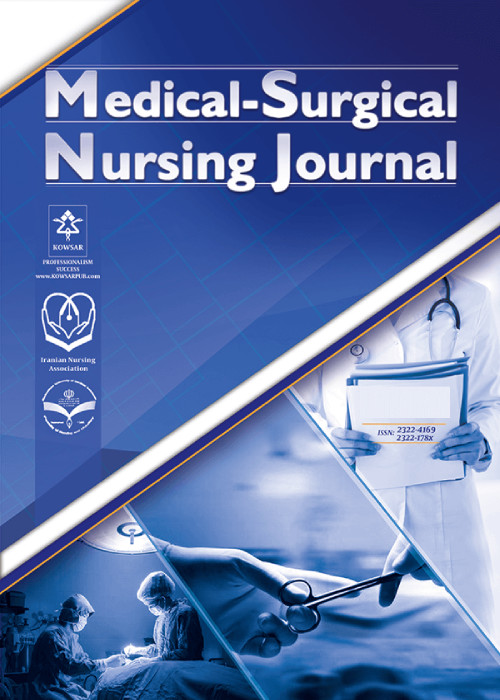فهرست مطالب

Iranian Journal Of Medical - Surgical Nursing
Volume:11 Issue: 3, Aug 2022
- تاریخ انتشار: 1401/06/19
- تعداد عناوین: 6
-
-
Page 1Background
In organizational analysis, competence and performance are fundamental issues. To ensure the quality of nursing care, it seems essential to evaluate nurses’ clinical competence (CC) and clinical performance (CP) as the largest group of professionals in the healthcare system.
ObjectivesThis study aimed to examine the CC and CP of nurses and other related factors.
MethodsThis cross-sectional study involved 220 nurses from various wards of Shahid Beheshti hospital in Kashan, Iran, in 2020. The samples were randomly selected based on the quota assigned to each section (coin toss). Then, 220 selected nurses filled out the CC questionnaire by self-reporting, and among them, the performance of 50 nurses was observed randomly (tossing a coin) in an entire work shift. The data collection tools included a personal information questionnaire and a checklist for evaluating CC and CP. The data were analyzed using SPSS software (version 16; SPSS Inc., Chicago, IL, USA). Data analysis was carried out using descriptive statistical methods, t-tests, analysis of variance, and Spearman and Pearson correlation coefficients. A P-value < 0.05 was considered statistically significant in all tests.
ResultsThe mean age of the participants was 31.15 ± 6.26 years. Moreover, the participants’ mean scores of work experience and work experience in the current ward were 7.57 ± 5.73 and 4.02 ± 3.88 years, respectively. The nurses’ mean scores of CC and CP were 80.79 ± 12.09 (out of 100) and 70.30 ± 11.94 (out of 100), respectively. Female subjects had a significantly higher mean score in terms of CC than male subjects. Additionally, married nurses had a higher mean score than single nurses (P < 0.05). Nurses in the critical care wards and emergency wards scored the highest (89.09 ± 12.09) and lowest (76.39 ± 12.65) regarding CC, respectively, which was statistically significant (P < 0.05). Furthermore, nurses with official employment had the highest mean CC score; nevertheless, nurses with designated employment had the lowest mean CC score, which was statistically significant (P < 0.05). According to the correlation test, nurses’ CC and CP were also associated with age, marital status, work experience in the current ward, and type of employment (P < 0.05).
ConclusionsThe CP and CC of the nurses participating in this study were satisfactory. Regarding the relationship between the CP score with marital status, workplace sector, employment status, age, general work experience, and current work experience, it is suggested to consider the aforementioned variables in programs for the improvement of nurses’ CP.
Keywords: Clinical Competence, Clinical Performance, Nursing, Evaluation -
Page 2Background
Managing stress and improving the nutritional status of cancer patients can lead to better physical and mental conditions, more desirable treatment outcomes, and improved feelings and engagement in the treatment process.
ObjectivesThis study sought to examine the effect of an educational-supportive intervention on the perceived stress and nutritional status of breast cancer patients undergoing chemotherapy.
MethodsThis quasi-experimental study was conducted on 80 women with breast cancer admitted to Khatam Al-Anbia (PBUH) and Ali Ibn Abi Talib (AS) hospitals affiliated with Zahedan University of Medical Sciences in 2022. Participants were selected using convenience sampling and randomly divided into 2 intervention and control groups. In the intervention group, participants attended 4 training sessions focusing on the patients’ common problems, proper nutrition, and prescribed treatment. The training session was performed at the patient’s bedside and lasted 45 - 60 minutes. In the control group, patients received no intervention except for hospital routine training. Data were collected from both groups before and 6 weeks after the intervention using the Perceived Stress Scale and patient-generated subjective global assessment (PG-SGA). Data were analyzed using SPSS version 22 using the pairedsamples t test, independent samples t test, and chi-square test. Data analysis was performed at a significance level of less than 0.05 (P < 0.05).
ResultsThe mean perceived stress scores were changed from 52.250 ± 2.284 to 32.125 ± 7.390 in the intervention group and 51.475 ± 2.773 to 48.425 ± 2.011 in the control group. The mean perceived stress scores were significantly higher in the intervention group than in the control group (P < 0.001). Moreover, the mean scores of the nutritional status were changed from 7.005 ± 41.40 to 1.94 ± 19.95 in the intervention group and 7.561 ± 40.58 to 5.177 ± 49.65 in the control group. The mean nutritional status scores were significantly higher in the intervention group than in the control group (P < 0.001).
ConclusionsGiven the positive effect of the educational-supportive intervention on reducing stress and improving nutritional status, these interventions can be incorporated into training and care programs to improve nutritional status and reduce stress in patients with breast cancer.
Keywords: Education, Support, Stress, Nutrition, Breast Cancer, Chemotherapy -
Page 3Background
Technological advancements and ease of communicating with and educating patients with kidney failure using various technologies have facilitated the achievement of treatment goals.
ObjectivesThe present study aimed to examine the effect of mHealth training on treatment adherence in hemodialysis patients in Zahedan.
MethodsThis quasi-experimental study was conducted on 80 hemodialysis patients admitted to teaching hospitals in Zahedan in 2022. The participants were selected using convenience sampling and were divided into two intervention and control groups by allocation with permutation blocks. In addition to routine training, the participants in the intervention group received mHealth training in five areas of treatment adherence using a smartphone application (My Dialysis) developed by the researcher. The participants in the control group received only routine training. The data were collected by a demographic information form, the Media Literacy Questionnaire, and the End-Stage Renal Disease Adherence Questionnaire (ESRD-AQ) in both groups before and three months after the intervention. The collected data were analyzed with SPSS (version 26) using the paired and independent samples t-test, chi-square test, and analysis of covariance (ANCOVA) at the significance level of less than 0.05 (P < 0.05).
ResultsThe mean treatment adherence score for the patients in the control group increased from 1011.87 ± 150.96 before the intervention to 1110.62 ± 86.95 after the intervention, showing a significant increase (P < 0.001). Besides, the mean treatment adherence score for the patients in the intervention group increased significantly from 1067.50 ± 122.24 before the intervention to 1161.25 ± 49.98 after the intervention (P > 0.001). The results of ANCOVA to control for the significant effect of the pretest scores and the disease duration showed that the patients’ mean treatment adherence scores in the two groups significantly differed after the intervention (P < 0.05).
ConclusionsThis study confirmed the significant positive effects of mHealth training on the treatment adherence of dialysis patients. Thus, considering the effectiveness of routine training, mHealth training can be used with routine training in treatment programs for hemodialysis patients to improve their treatment adherence.
Keywords: Treatment Adherence, Hemodialysis, mHealth -
Page 4Background
Birth injuries occur during the birth process. The progress made in birth care and prenatal diagnosis has reduced the prevalence of birth injuries around the globe.
ObjectivesThis study aimed to determine the prevalence of birth injuries and their determining factors in Hamadan Fatemieh Hospital, 2020 - 2021.
MethodsIn this case- control study, all live births between 2020 and 2021 were examined on the first day of birth. In the case of detecting any birth injury, the cases were categorized by injury type and were recorded on a pre-designed form along with the risk factors. An equal number of neonates with no birth injuries were also examined for the same risk factors. Independent test and chi-square test was used to assess in two groups. The results were analyzed using SPSS version 16.
ResultsDuring the study, 66 birth injuries were recorded among 5,592 births (incidence rate 11.8 per 1,000 live births). Proportion incidence of birth injuries were caput succedaneum (28.8%), cephalohematoma (22.7%), ecchymosis (9.1%), subgaleal hemorrhage (7.6%), hypoxic-ischemic encephalopathy (7.6%), Erb’s palsy (6.1%), abrasion and subconjunctival hemorrhage (3%), and laceration and humerus fracture and clavicle fracture (1.5%). Control group was included 65 neonates without any types of birth injury whom matched with cases in gestational age and weight. According to findings of two groups, these factors lower gestational age, lower Apgar, delivery method (vaginal), and responsible person for delivery significantly related with incidence of birth injuries (P-value < 0.05).
ConclusionsThe most prevalent birth injury in Fatemieh Hamadan Medical Training Center was soft tissue injuries, that course training should be provided for health workers.
Keywords: Birth Injuries, Incidence, Etiology, Risk Factors -
Page 5Background
Psoriasis is an inflammatory skin disease that leads to mental complications followed by the patient’s isolation. Therefore, understanding patients’ perceptions of this disease can be effective in planning their care.
ObjectivesThe present study sought to explore the experiences of patients with psoriasis.
MethodsThis qualitative study was conducted using a descriptive phenomenological approach within 2018 - 2019 on psoriasis patients admitted to the skin clinics of hospitals in Zahedan, Iran. The participants were 10 patients with psoriasiswhowere selected via purposive sampling. The data were collected using in-depth and individual semi-structured interviews, and data analysis was performed simultaneously with data collection using Colaizzi’s content analysis model.
ResultsThe main themes describing the experiences of patients with psoriasis were the progression of the disease in the shadow of the ignorance of the medical staff, physical and psychological suffering, and the ominous shadow of fear of the disease recurrence.
ConclusionsThe results showed that the progression of the disease due to inadequate knowledge of the medical staff is an important challenge for patients with psoriasis. Furthermore, the recurrence of the disease can be a serious threat to trust in the current treatments of this disease. Physical and mental suffering can lead to the isolation of these patients and makes bearing the burden of the disease very challenging for the affected individuals. Therefore, psychiatrists, doctors, and nurses should try to raise the patients’ morale and improve their body image, self-confidence, and physical care by increasing their awareness of patients’ experiences and understanding them.
Keywords: Psoriasis, Descriptive Phenomenology, Colaizzi’s Approach -
Page 6Introduction
Cholecystectomy is one of the most common surgeries in the world. The gallbladder is removed due to acute or chronic cholecystitis, obstruction of the bile duct, or residual stones. In some cases, part of the gallbladder may remain in place for various reasons, including lack of access and visibility.
Case PresentationIn this study, we introduced a 41-year-old male patient who, after subtotal laparoscopic cholecystectomy, showed residual symptoms of the gallbladder and underwent laparoscopic surgery to remove the remnants.
ConclusionsPerforming subtotal cholecystectomy surgery involves a lot of complications and costs due to the possibility of recurrence and the need for re-surgery, which should be minimized.
Keywords: Gallbladder Retention, Cholecystectomy, Gallbladder, Case Report


